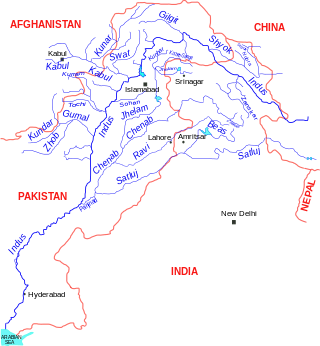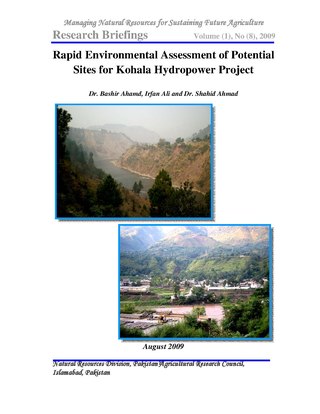
Tarbela Dam is an earth-filled dam along the Indus River in Pakistan's Khyber Pakhtunkhwa province. It is located mainly in the Swabi District Tehsil Topi of the province. It is about 20 km (10 mi) from the city of Swabi KPK, 105 km (65 mi) northwest of Islamabad, and 125 km (80 mi) east of Peshawar. It is the largest earth-filled dam in the world. The dam is 143 metres (470 ft) high above the riverbed and its reservoir, Tarbela Lake, has a surface area of approximately 250 square kilometres (97 sq mi).

The Indus Water Treaty (IWT) is a water-distribution treaty between India and Pakistan, arranged and negotiated by the World Bank, to use the water available in the Indus River and its tributaries. It was signed in Karachi on 19 September 1960 by then Indian Prime Minister Jawaharlal Nehru and then Pakistani president Ayub Khan.
Diamer-Bhasha Dam is a concreted-filled gravity dam, in the preliminary stages of construction, on the River Indus between Kohistan district in Khyber Pakhtunkhwa and Diamer district in Gilgit Baltistan, Pakistan administered Kashmir. Its foundation stone was laid by the then Prime Minister of Pakistan in 1998. The dam site is situated near a place called "Bhasha", hence the name which is 40 km downstream of Chilas town and 315 km from Tarbela Dam. The eight million acre feet (MAF) reservoir with 272-metre height will be the tallest roller compact concrete (RCC) dam in the world.

Ghazi-Barotha Hydropower Project is a 1,450 MW run-of-the-river hydropower, connected to the Indus River. It is located about 10 km (6.2 mi) west of Attock in the Punjab province and east of Haripur in the Khyber Pakhtunkhwa province of Pakistan. Construction of the project began in 1995. It consists of five generators, each possessing a maximum power generation capacity of 290 MW. The inauguration of the plant took place on 19 August 2003, presided over by the then President General Pervez Musharraf. It also saw the commissioning of the first two of the five generators i.e. Unit 1 and Unit 2. The last generator was commissioned on 6 April, 2004, and the project was completed by December the same year. It costed US$2.1 billion with funding from Pakistan's Water and Power Development Authority, the World Bank, Asian Development Bank, Japan Bank for International Cooperation, Kreditanstalt für Wiederaufbau, European Investment Bank and Islamic Development Bank.

The Pakistan Water & Power Development Authority is a government-owned public utility maintaining power and water in Pakistan, although it does not manage thermal power. WAPDA includes Tarbela and Mangla dams among its resources. Its headquarters are in Lahore.
The Akhori Dam project is a proposed multipurpose dam in Pakistan, about 60 km west of Islamabad. Developed by Pakistani Water and Power Development Authority (WAPDA) as part of its Water Vision 2025, it has been proposed by the former Pakistan Muslim League (Q)'s Government.
Mohmand Dam is an under construction multi-purpose concrete-faced rock-filled dam located on the Swat River approximately 37 km north of Peshawar and 5 km upstream of Munda Headworks in Mohmand District, Khyber Pakhtunkhwa, Pakistan.

The Neelum–Jhelum Hydropower Plant is part of a run-of-the-river hydroelectric power project in Azad Kashmir (AJK) designed to divert water from the Neelum River to a power station on the Jhelum River. The power station is located 42 km (26 mi) south of Muzaffarabad, and has an installed capacity of 969 MW. Construction on the project began in 2008 after a Chinese consortium was awarded the construction contract in July 2007. After many years of delays, the first generator was commissioned in April 2018 and the entire project was completed in August 2018 when the fourth and last unit was synchronized with the national grid on 13 August and attained its maximum generation capacity of 969 MW on 14 August 2018. It will generate 5,150 GWh per year at the levelised tariff of Rs 13.50 per unit for 30 years.
Bunji Dam is proposed large hydro-power project on Indus River in Bunji, Gilgit Baltistan, Pakistan. If built it would be Pakistan's second largest hydropower project.
Water Vision 2025 is a National Water resource and Hydropower Development Program being undertaken by WAPDA to tackle the severe water and energy crisis in Pakistan. Since the construction of Mangla Dam, the country's population has risen to 180 million and is estimated to reach 280 million by 2025, resulting in a severe energy and water crisis.
The Khan Khwar Hydropower Plant is a run-of-the-river project located near the town of Besham in the Shangla District of the Khyber Pakhtunkhwa province of Pakistan. It is situated on the Khan Khwar River, a right bank tributary of the Indus River. It is approximately 265 km from the federal capital of Islamabad and 350 km from the provincial capital of Peshawar.
The Allai Khwar Hydropower Plant is a run-of-the-river, high head project of 687 metres, located in the Battagram District on the Allai Khwar River, a left bank tributary of the Indus River in Khyber Pakhtunkhwa province, Pakistan. It is approximately 245 km from the federal capital of Islamabad and 330 km from the provincial capital of Peshawar.
The Ratle Hydroelectric Plant is a run-of-the-river hydroelectric power station, with permitted pondage under the Indus Water Treaty, currently under construction on the Chenab River, downstream of the village near Drabshalla in Kishtwar district of the Indian Union Territory of Jammu and Kashmir. The project includes a 133 m (436 ft) tall gravity dam and two power stations adjacent to one another. Water from the dam will be diverted through four intake tunnels about 400 m (0.25 mi) southwest to the power stations. The main power station will contain four 205 MW Francis turbines and the auxiliary power station will contain one 30 MW Francis turbine. The installed capacity of both power stations will be 850 MW. On 25 June 2013, Prime Minister Manmohan Singh laid the foundation stone for the dam. Pakistan has frequently alleged that it violates the Indus Waters Treaty.
The Duber Khwar Hydropower Plant is located near the town of Pattan in Kohistan, Khyber Pakhtunkhwa, Pakistan on the Duber Khwar River, a right bank tributary of the Indus River. It is approximately 340 km NW from Islamabad, the federal capital of Pakistan.
Golen Gol Hydropower Plant (GGHPP) is a hydroelectric power plant located on the Golen Gol River - a major left tributary of Mastuj River in Chitral District of Khyber Pakhtunkhwa province of Pakistan. The dam is located approximately 25 km from Chitral city, and 365 km from the provincial capital of Peshawar. Construction of Golen Gol project began in 2011, and was completed in January 2018.

The Kohala Hydropower Project is a proposed run-of-the-river, high head project of 316 meters that will be located near Kohala, in Azad Kashmir. In 2020 the project's agreement was finalised later it was formally signed in a ceremony attended by the Pakistani Prime Minister Imran khan, and Chinese ambassador.
Lieutenant General Muzammil Hussain (Retired) is a former senior officer in the Pakistan Army and former Chairman of Pakistan's Water and Power Development Authority (WAPDA).
Lower Spat Gah Hydropower Project is a hydroelectric power project located in Kohistan, Khyber Pakhtunkhwa province of Pakistan.







